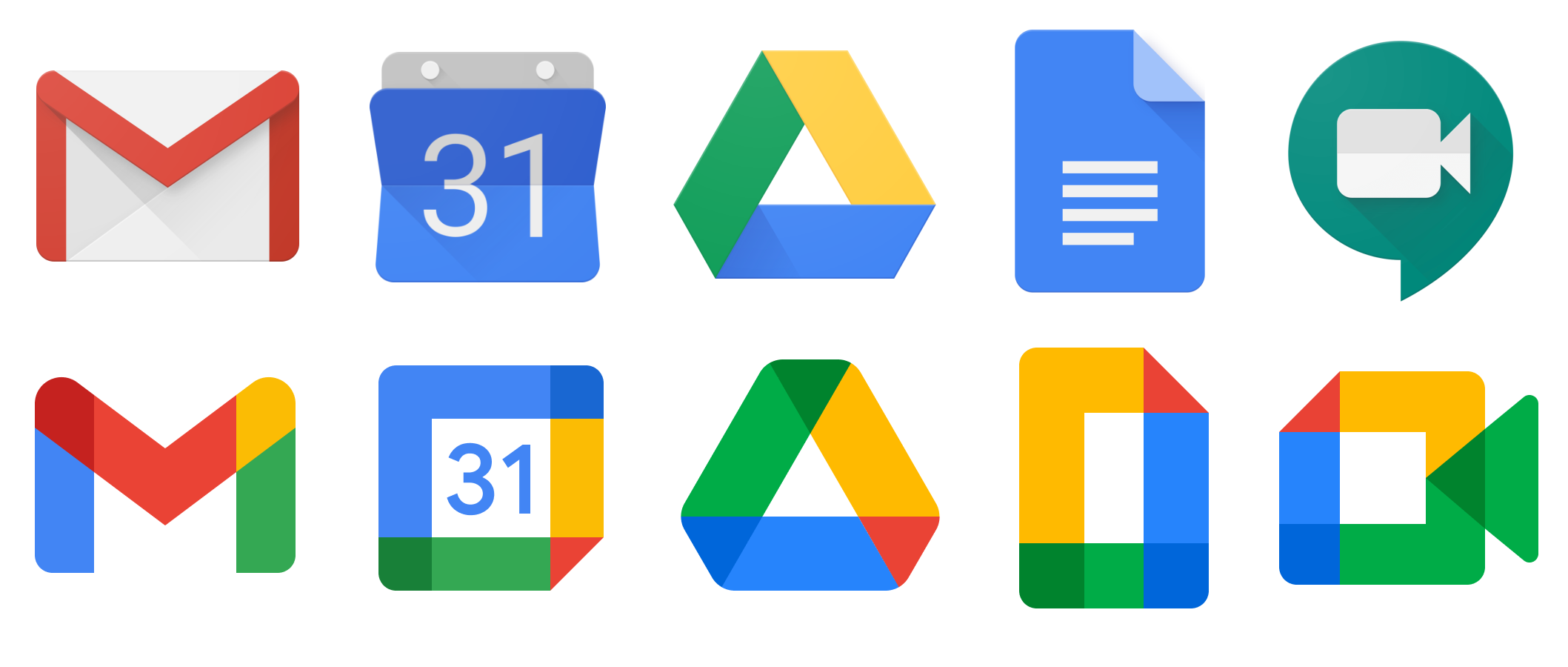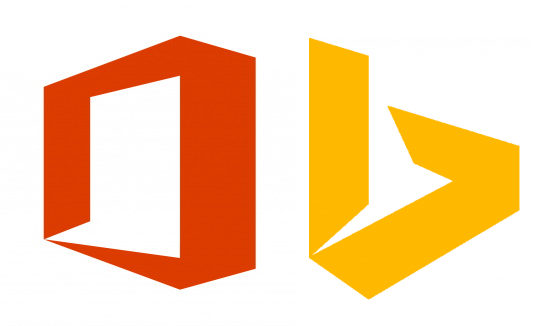
Google "reimagined" G Suite as Google Workspace and degenerated an amazing family of colorful logos instead of familiar, recognizable, and in the case of Gmail - even iconic icons. In their place, little rainbow drops have appeared, which we will now struggle to distinguish from each other in the browser tabs. Companies love to talk loudly and a lot about corporate design, so as an antidote, I'll try to explain on my fingers why these icons are so bad and why they won't last long.
First, I understand Google's intent. They try to unify the visual language of the various applications in their suite. This can be important, especially for a company that is ditching apps, services, design languages, and other things like throwing ballast off a falling balloon (a surprisingly good comparison, in fact).
We've seen so many icon styles at Google over the years that it's hard to force ourselves to speculate on new ones. To paraphrase Sun Tzu, if you wait long enough by the river, the bodies of your favorite Google products will float by. Better not to get attached to them.
But sometimes they do something so pointless that anyone who is interested in it at all is obliged to express their opinion to the company in person - and declare that they clearly failed. The last time I felt this way was after I closed Google Reader. Since I and hundreds of millions of other people will have to stare at these ugly new icons all day long until they are replaced, perhaps a little noise will speed things up a bit.
Sorry to be straightforward, but this is a necessary antidote to the endless design stories that accompanyalmost all of these heady redesigns . We will restrict discussion of errors in these logos in only three respects: color, shape, and brand.
Colour
Color is one of the most visible attributes; you can easily recognize colors even with your peripheral vision. Thus, crisp color is important in many ways for text and design. Why do you think companies are going crazy with all these shades of blue?
This is one of the reasons why it is so easy to distinguish between the icons of the most popular Google applications. Gmail red is 10+ years old, blue Calendar is pretty old too. Meet's teal (blue-green) bird coloration probably should have just stayed green like its Hangouts predecessor, but it stands out a little. Just like Keep (remember Keep?) And a few other nonessential services. More importantly, they whole - except for a few who made good use of color, like Maps, before theiralso killed.
There are two problems with the colors of the new icons. First, they don't really have a color. There is a rainbow in all, which immediately makes it difficult to distinguish at a glance. Remember, you will never see them as big as in the picture above. Most often they will be about this size:

Maybe even smaller. And never so close to each other. I don’t know about you, but I can’t tell the difference unless we look closely. What exactly are you looking for? Each icon has a different color, sometimes even in a different order or direction - some go red, yellow, green, blue, and one red, yellow, blue, green? Three (with Gmail) clockwise and two counterclockwise. It doesn't sound important, but your eye picks up these things to confuse you even more.
Maybe it’s better to start with red in the upper left corner or something like that. The main Google logo doesn't change colors at random, right? Ultimately, these little lumps are just like toys or crumpled candy wrappers. A plaid at best, and that's Slack territory.
At first I thought that small red triangular tongues in the corners would be a good visual indicator, but for some reason they also messed up. The tabs in the icons could be located in different corners, but in the Calendar and Disk they are in the lower right corner. The triangles are at least of different shapes, but this is just luck from the geometry of the figures.
You will also notice that the icons seem to be outweighed to the side. This is because different colors have different visual significance against a light background. The darker ones appear more strongly against a white background than the yellow or tiny bit of red, which causes the icons to roll into bold Ls, on the left in Gmail and Calendar, on the bottom left in Drive and Meet, and on the bottom right in Docs. But in an inactive tab, the lighter color is more noticeable, and these Ls will end up on the other side.
I guess the designers have been looking at large logos for a long time - and not too much thought about how they would look in real use on the screen of a cheap Chromebook or Android phone. This conclusion can be made because each icon has very small details that will disappear 20 pixels wide.
The form
This brings us to the problem of form because the perceived form of these icons will change depending on the background. The original icons solved the problem with a unique one-piece shape and the background didn't really bleed. Even the chamber-like "hole" in Meet has received texture and shadow.
Transparent fragments should be handled very carefully: positive and negative space and all that. If the background shows through in part of the logo, then the situation may be affected by an arbitrary UI or custom theme. Will those holey logos look good on a dark gray inactive tab? Or will the hole always remain white, making it positive space on a dark background and negative space on a white background? I'm not saying there is a 100% correct answer, but whatever it is, Google didn't pick it.
In any case, these icons are badly shaped. They are all hollow, and four of them are rectangular if Gmail's negative space is included (and we do - Google taught us this). The general shape of the container is sometimes ideal for use, but at first glance, four out of five are essentially angular O's. Do you need a tall O, a pointed one, or one of two square O's with slightly different color patterns? From a distance it is incomprehensible only if you look very carefully.
Now that I thought about it, the forms do resemble Office and Bing a lot, right? That's not good either!

While we're on this topic, the thin open-space typeface in the Calendar icon is pretty anemic compared to the big thick border, right? Maybe bold should have been.
Last but not least, overlapping colors creates problems. First, the Disc logo becomes a biohazard symbol. Second, it adds a lot of complexity that is difficult to trace on a small scale. The original Disc logo had three confident colors and a small shadow so you can see that it is a Mobius strip, implying infinity, not just a triangle (that's gone, so why leave a triangle?), But the colors set off each other: blue and yellow make up green , two primary - and their derivative.
We now have as many as three primary colors, one secondary and two tertiary (assuming darkness is a color). They actually don't help in any way in expressing forms. Are you looking "through" them? It doesn't seem right. They are kind of folded, but how? Are the ribbons made by curling? I don’t think so. Forms are not things, but just diagrams, hints of what they once were, whose features have been removed a little more than they should have.
Brand name
It's not the first time Google has flushed valuables down the toilet. But sometimes it's obvious that everything is going well. The Gmail logo was a good thing. I admit, I liked the old angular icon better when they switched to the rounded one a few years ago, but this one stuck. The natural shape of the M envelope is so well defined and the red and white color is instantly recognizable and readable - this is the very logo we've been using for a long, long time.
The problem is that Gmail has been a separate, completely unbeatable brand for ten years now (this is a whole era in technology, not to mention logos). And it has been put on the same shelf with other services that are not as trusted or widely used.
Now Gmail is just another rainbow shape in a sea of very similar rainbows that tells the user, “This service is not special to us. This is not a service that has worked so well for you for so long. It's just one finger on the giant's hand. And now you can never look at one thing while forgetting about the other. "
It's the same with all the other little colored wheels: you will never forget that they are all part of the same machine, which knows everything you are looking for, every site you visit, and now everything you do on work. Oh yes, they are very polite. But make no mistake, homogeneous branding (for all its color irregularities) is a prelude to a brand crisis in which you are no longer just a Gmail user, you are in the Google home all day, every day.
“This is the moment we free ourselves from defining the structure and role of our offerings in terms that were invented by someone else in a very different era,” Google VP Javier Saltero explained in an interview with Fast Company .
The message is clear: do away with the old days when your trust was built - and enter a new time where you benefit from that trust.